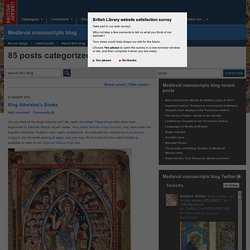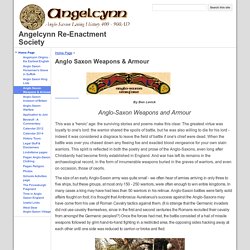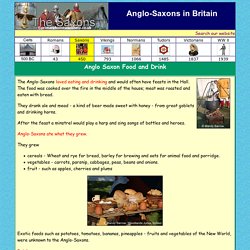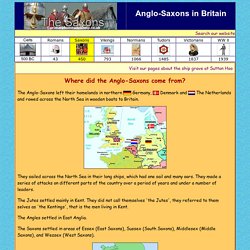

Primary History - Anglo-Saxons - Growing up. Anglo saxons. Medieval manuscripts blog: Anglo-Saxon. As many of you hopefully already know, the British Library offers two different ways to work with digital versions of our medieval manuscripts.

Our Digitised Manuscripts website contains complete coverage of many of the items in our collections, while the Catalogue of Illuminated Manuscripts is another very useful source of digital catalogue records and images. Miniature of the Crucifixion, from a leaf from a missal, northern France or Netherlands, 2nd half of the 13th century, Additional MS 34652, f. 5 The Catalogue of Illuminated Manuscripts is based on a Microsoft Access database, so it has allowed us to develop some very detailed search tools.
CIM (as we call it) is particularly useful for iconographical searches, since each image is described individually. You can search for various terms either in these specific image descriptions, or within the wider manuscript records. Or, if you are just interested in exploring, why not take a tour of some collection highlights? Anglo Saxon Weapons & Armour - Angelcynn Re-Enactment Society. The principle weapon of the Anglo-Saxons was the spear.

Spearheads came in many styles (Swanton classified 21 different forms), but were usually leaf- or 'kite-' shaped and had a socket for attachment to the shaft. It was usually diamond-shaped or lentoid in cross section, while the socket which continued from the narrow neck of the spearhead was split on one side and usually had an iron rivet to attach it to the shaft, which was usually of ash. Spearheads vary considerably in length from a few inches to two feet or more, and the basic forms change very little throughout the whole Anglo-Saxon period. The overall length of the spear was around 6'6" - 8' (2.00 - 2.50m), and the butt of the spear was often capped with a metal ferrule. Spears were used both for hand to hand combat and as javelins.
Anglo Saxon Armour. SUTTON HOO HELMET: This helmet was found in the ship-grave at Sutton Hoo.

Can you see the two dragon's heads nose-to-nose at the front? From the little pieces it is possible to see what the whole helmet might have looked like: Reconstructed helmet. Here is what a shield probably looked like: Only the 'boss' (the middle part) and some of the metal deocorations have survived. This is the dragon from the left-hand side of the shield: This is a bird of prey. The wooden part of the shield has rotted away. This sword was found in Germany: The blade is covered by a sheath decorated with with gold. Saxons.jpg (JPEG Image, 500 × 342 pixels)
Anglo-Saxon Female Names. EBK for Kids: Anglo-Saxon Food & Drink. Anglo Saxon life - Food and Drink. The Anglo-Saxons loved eating and drinking and would often have feasts in the Hall.

The food was cooked over the fire in the middle of the house; meat was roasted and eaten with bread. They drank ale and mead - a kind of beer made sweet with honey - from great goblets and drinking horns. After the feast a minstrel would play a harp and sing songs of battles and heroes. Anglo-Saxons ate what they grew. They grew cereals - Wheat and rye for bread, barley for brewing and oats for animal food and porridge. Exotic foods such as potatoes, tomatoes, bananas, pineapples - fruits and vegetables of the New World, were unknown to the Anglo-Saxons. Drink Barley was used to make weak beer, which was drunk instead of water.
Most Anglo-Saxons were vegetarians because they could not get meat very often. Animals Pigs were important for food because they produce large litters, which would quickly mature and be ready for slaughter. Anglo-Saxon clothes - women. 5th to 7th centuries Women wore an under-dress of linen or wool with long sleeves and a draw-string neck.

Sleeves were fastened with clasps for wealthier women, or drawn together with braid or string for poorer women. The outer dress was a tube of material, rather like a pinafore, and often called a ‘peplos’. A pair of shoulder-brooches or clasps held this onto the under-dress. A belt was worn, from which various accessories were hung. There is some linguistic evidence that shawls were worn, as well as cloaks, which were fastened either centrally or to the right shoulder with a brooch. Anglo saxon. Primary History - Anglo-Saxons - Who were they? Where did the Anglo-Saxons come from? The Anglo-Saxons left their homelands in northern Germany, Denmark and The Netherlands and rowed across the North Sea in wooden boats to Britain.

They sailed across the North Sea in their long ships, which had one sail and many oars. They made a series of attacks on different parts of the country over a period of years and under a number of leaders. The Jutes settled mainly in Kent. The Angles settled in East Anglia. The Saxons settled in areas of Essex (East Saxons), Sussex (South Saxons), Middlesex (Middle Saxons), and Wessex (West Saxons). British Kingdoms (each area ruled by a different king)